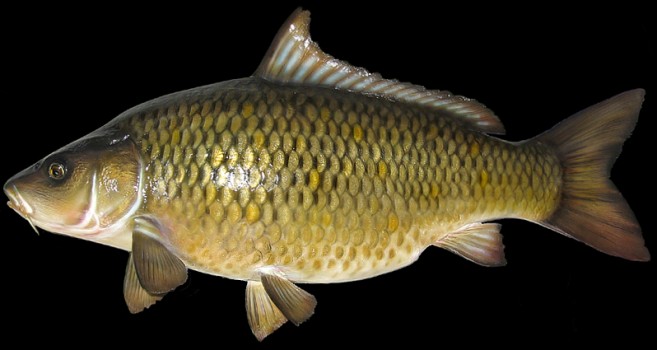What Does a Carp Fish Look Like? Identify Carp vs Catfish

Telling Fish Apart
Ugly! That’s the first thing that likely comes to mind when most people see a carp fish. Believe it or not, carp actually come from the same family of fish as the minnow. Carp, like most other fish, are born small and must survive many perils to make it to a decent age. Unlike minnow, carp don’t stop growing once they’ve made it past that juvenile stage. The biggest carp on official record that was caught on rod and reel weighed in at 105 lbs. Other reports of Siamese Giant Carp are said to weigh much more. But back to the question, what does a carp fish look like? If you also want to know if carp bites humans, read this article.
 To the carp angler, these fish are anything but ugly. Carp tend to be lazy fish once they gain some size, but are far from docile when hooked. They are known to belong to any group of top fighting freshwater fish named by fishermen. Carp fish can be easily distinguished between other major families of fish like salmon, tuna, trout, or halibut. They don’t look anything like these kinds of fish. Within their own family however, carp could be confused as catfish, suckers, or small mouth buffalo (see also how to catch buffalo fish). Catfish are quite diverse as a species, and carp are the same way.
To the carp angler, these fish are anything but ugly. Carp tend to be lazy fish once they gain some size, but are far from docile when hooked. They are known to belong to any group of top fighting freshwater fish named by fishermen. Carp fish can be easily distinguished between other major families of fish like salmon, tuna, trout, or halibut. They don’t look anything like these kinds of fish. Within their own family however, carp could be confused as catfish, suckers, or small mouth buffalo (see also how to catch buffalo fish). Catfish are quite diverse as a species, and carp are the same way.
If you also want to know the difference between a buffalo fish and a carp, we’ve made an article for that.
What Similarities do Carp and Catfish Share?
Survey says….the #1 answer is WHISKERS! Known for those feeler protrusions or appendages coming out of the fishes’ face, carp and catfish both have them. At a quick glance, the untrained eye might mistake a carp for a catfish due to those pointers on its face. The seasoned fisherman knows the difference in an instant, and upon closer inspection the untrained onlooker will also see them as different fish. By the way, if you said they both are amazingly strong fighting fish, survey would have said ch-ching!
Here’s also another article about ghost carp that you might want to read.
The Major Differences Between Carp and Catfish
Catfish have more whiskers than carp, and they grow longer than a carp’s short barbs. This is an immediate separation from just an inspection of the face, or head of the fish. Moving on to the bodies of these fish, there are obvious variations in the structure of their fins. The individual scales of a carp also get much larger than those of a catfish. Another observation in change is the way both fish’ bodies grow. As carp get bigger, they tend to grow larger than they do longer. On the other hand, catfish seem to grow more proportionally in both directions.
Identifying Different Species of Carp
Catfish is now out of the question. We know the difference, and can tell what a carp looks like. Then one day on your favorite lake, you bring in a lunker and you think it’s a carp though it looks quite different than ones you’ve seen before. Let’s take a look at some of the different carp you might find in lakes or watersheds around the world. Catsandcarp.com is another great source of info on carp species.
- Common Carp: The most plentiful of carp. They are light to dark brown in color, with large scales, and small hook like growths on the side of their mouth.
- Leather Carp: Here’s one species of carp that doesn’t have large scales. In fact it appears they have no scales at all! Leather carp don’t grow as big as common carp, and large ones are prized catches.
- Grass Carp: These guys are vegetation eaters, though they have been known to go for bread or boilies. They don’t have the whiskers, and grow big and long, a little different than most kinds of carp. They have been used a means of weed control.
- Mirror Carp: Notably different than other carp, their scales are spotted and vary in size. Some of the biggest carp caught have been mirror carp.
- Crucian Carp: The smallest of the carp. They don’t get much heavier than 3 lbs., and have no barbs on their face.
- Silver and Big Head Carp: Similar in appearance, the silver carp have a narrower head and body. Both have eyes set lower on their head. Here’s an interesting video about Silver Carp!
The Origin and Global Movement of Carp
 In the waterways of today’s current world, Carp can be found and caught just about anywhere. This wasn’t always the case. Carp are believed to have their origin in Europe and Asia, where their capture is still popular among fishermen. European carp fishing goes back ages, and many of the rods, reels, and techniques used to catch carp can be attributed to European anglers of ages past.
In the waterways of today’s current world, Carp can be found and caught just about anywhere. This wasn’t always the case. Carp are believed to have their origin in Europe and Asia, where their capture is still popular among fishermen. European carp fishing goes back ages, and many of the rods, reels, and techniques used to catch carp can be attributed to European anglers of ages past.
Carp are believed to have been introduced to the United States in the 1880’s for the purpose of sport fishing. Today they are reportedly found wild in every state except Alaska. Silver and Big Head carp have less of a presence in American waters, which is thought to be simply due to a later introduction into these water systems.
Two interesting facts about carp have led to their label as an invasive species in United States waters. First, Carp are omnivorous fish. They can eat almost anything including plant and meat substances, which gives them an obvious edge in the wild. Second, most carp are able to survive in low oxygen content (dirty) water. The combination of these two biological advantages allow carp rapid growth as a whole in many watersheds around America, as well as other countries. They are for this reason controlled and regulated in many areas around the world.
What Does a Carp Fish Look Like on The Grill?
 According to most carp anglers, someone would have to be pretty hungry to wind up preparing carp for the dinner table. The truth of this matter is that people are plenty hungry around the world in general, and carp (though still not thought of as a top eating fish) often fills that need. Carp is not popular at all in more affluent parts of the world, probably for a few reasons. For one thing, carp are bony which make them difficult to clean and prep. Perhaps more of a turn off is their meat which is full of oil, and gives off that fishy smell and taste. The most likely reason for the avoidance is the water that carp tend to inhabit. The thought of dirty water and the things carp eat in such water, might be just enough to turn a sturdy stomach sour. What does a carp fish look like? Well, that’s easy! Just don’t ask me what a carp fish tastes like.
According to most carp anglers, someone would have to be pretty hungry to wind up preparing carp for the dinner table. The truth of this matter is that people are plenty hungry around the world in general, and carp (though still not thought of as a top eating fish) often fills that need. Carp is not popular at all in more affluent parts of the world, probably for a few reasons. For one thing, carp are bony which make them difficult to clean and prep. Perhaps more of a turn off is their meat which is full of oil, and gives off that fishy smell and taste. The most likely reason for the avoidance is the water that carp tend to inhabit. The thought of dirty water and the things carp eat in such water, might be just enough to turn a sturdy stomach sour. What does a carp fish look like? Well, that’s easy! Just don’t ask me what a carp fish tastes like.
Have you eaten Carp? If yes, is Carp good to eat? If not, would you try it? Tell us about it in the comment box! We want to know.
As an Amazon Associate, Fishermen's Angle earns from qualifying purchases. We get commissions for purchases made through links in this post.
